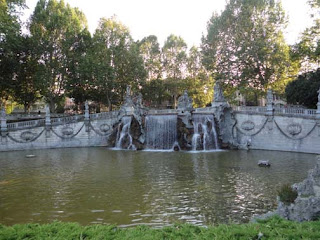Believe it or not, this red brick structure is the backside of the Castle of Valentino. The wild and crazy Italians have quite a few two-tone buildings like this.
The magnificent-looking Mole Antonelliana is probably the most famous structure in Turin. Built 1863-1889, it was originally conceived as a Jewish synagogue but, financial problems resulted in the city taking it over. At 548 feet tall, it now houses the National Museum of Cinema and reckons to being the tallest museum in the world
I couldn't get the whole structure in one shot so, this shows the tip.
Want to go shopping on a very, very hot or very cold and rainy day in Turin? No problem, as Turin has blocks and blocks of covered arcades. Matter of fact, Turin supposedly has more covered arcades than any other city in the world.
Window shopping is popular.
So is advertising.
Four different rivers flow through Turin.
This water fountain sculpture is very impressive.
The detail is very amazing.
This is Palazzo Madama, a former home to several powerful woman in the 1600's (hence its name which is Italian for Madame) and since 1934 home to the City Museum of Ancient Art.
This impressive building, located in the same square as Palazzo Madama, has a more impressive pedigree: the Royal Palace of Turin.
Tourists taking pictures of water shooting up. It wasn't until cycling into Milan's city center that I remembered why I didn't like the city. The streets are lined with large cobblestones. The bike and your body shudder non-stop making cycling miserable. Built in 1778, this photo shows the world famous La Scala opera house.
This shopping arcade in Milan is one of the most famous in the world.
You can't help but stop and gawk at the detailings on the ceilings and roofs.
Expensive boutiques line the arcade and you can imagine the rents charged for this high traffic location. But, that's not a problem if you are an international juggernaut like McDonald's. I snapped this standing next to the entrance of McDonald's





























